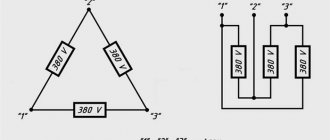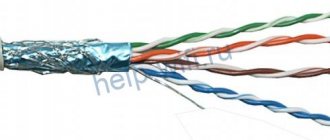Block.
This is a wheel with a groove around its circumference for a rope or chain. Blocks are used in lifting devices. A system of blocks and cables designed to increase load capacity is called a chain hoist. A single block can be either with a fixed axis (leveler) or movable (Fig. 2). A block with a fixed axis acts as a lever of the first kind with a fulcrum on its axis. Since the force arm is equal to the load arm (radius of the block), the ideal gain in force and speed is 1. The movable block acts as a lever of the second kind, since the load is located between the fulcrum and the force. The load arm (block radius) is half the force arm (block diameter). Therefore, for a moving block, the ideal strength gain is 2.
A simpler way to determine the ideal gain in force for a block or system of blocks is by the number of parallel ends of the rope holding the load, as is easy to figure out by looking at Fig. 2.
Leveling and moving blocks can be combined in different ways to increase power gains. Two, three or more blocks can be installed in one holder, and the end of the cable can be attached to either a fixed or movable holder.
Inclined plane.
An inclined plane is used to move heavy objects to a higher level without lifting them directly. Such devices include ramps, escalators, regular stairs, and conveyors (with rollers to reduce friction).
The ideal gain in force provided by an inclined plane (Fig. 5) is equal to the ratio of the distance over which the load moves to the distance covered by the point of application of the force. The first is the length of the inclined plane, and the second is the height to which the load rises. Since the hypotenuse is larger than the leg, an inclined plane always gives a gain in strength. The smaller the inclination of the plane, the greater the gain. This explains the fact that mountain roads and railways look like serpentines: the less steep the road, the easier it is to climb along it.
Differential gate.
These are essentially two wheels connected together and rotating around the same axis (Fig. 3), for example, a well gate with a handle.
A differential gate can provide gains in both strength and speed. It depends on where the force is applied and where the load is applied, since it acts as a first class lever. The fulcrum is located on a fixed (fixed) axis, and therefore the forces and loads are equal to the radii of the corresponding wheels. An example of such a device for gaining strength is a screwdriver, and for gaining speed is a grinding wheel.
Gears.
The system of two meshed gears sitting on shafts of the same diameter (Fig. 4) is to some extent similar to a differential gate ( see also
GEAR).
The speed of rotation of the wheels is inversely proportional to their diameter. If the small drive gear A
(to which the force is applied) is half the diameter of the large gear
B
, then it should rotate twice as fast.
Thus, the gain in force of such a gear is equal to 2. But if the points of application of force and load are swapped so that wheel B
becomes the drive, then the gain in force will be equal to 1/2, and the gain in speed will be 2.
Lever arm.
This is a rigid rod that can be freely rotated relative to a fixed point called the fulcrum. An example of a lever is a crowbar, a hammer with clefts, a wheelbarrow, or a broom.
Levers come in three types, differing in the relative position of the points of application of load and force and the fulcrum (Fig. 1). The ideal gain in leverage is equal to the distance ratio DE
from the point of application of the force to the point of support to the distance
DL
from the point of application of the load to the point of support.
For a lever of the first kind, the distance DE
is usually greater than
DL
, and therefore the ideal gain in force is greater than 1. For a lever of the second kind, the ideal gain in force is also greater than one.
As for the third type lever, the value DE
for it is less than
DL
, and therefore the gain in speed is greater than one.
The basic Law.
Although mechanisms allow for gains in strength or speed, the possibilities of such gains are limited by the law of conservation of energy. When applied to machines and mechanisms, it says: energy can neither appear nor disappear, it can only be converted into other types of energy or into work. Therefore, the output of a machine or mechanism cannot be more energy than the input. In addition, in real machines, part of the energy is lost due to friction. Since work can be converted into energy and vice versa, the law of conservation of energy for machines and mechanisms can be written as
Also on topic:
INDUSTRIAL REVOLUTION
Work at the input = Work at the output + Friction losses.
This shows, in particular, why a machine like a perpetual motion machine is impossible: due to the inevitable loss of energy due to friction, sooner or later it will stop.
Classification by time-current indicator
The number of false alarms of automatic circuit breakers under uneven load on the network is optimized due to different speeds of response to exceeding the rated current. The dependence of the network shutdown time on the strength of the flowing current determines the following types of circuit breakers:
- A. Available from European manufacturers. The most sensitive model. It responds instantly to deviations from the norm. Typically used to protect lines with connected high-precision equipment. (Current rating 2-3). Rarely installed.
- B. Designed for rooms equipped with old aluminum wiring. Suitable for long lines, lighting lines or circuits without possible sudden voltage changes. It turns off with a slight delay of 5-20 seconds at a current rating of 3-5.
- C. More often found in modern apartments to protect outlet lines into which a sufficient amount of electrical equipment is connected (washing machines, dishwashers, freezers, heaters, microwave ovens, LCD TVs). Shutdown occurs in 1-10 seconds at a current multiple of 5-10. This principle is needed to stabilize operation with a slight difference.
- D. Protection is optimal for lines with transformers or high inrush currents. Circuit breakers of this class cannot be connected to consumers oriented to work with protection classes C and B. At 10-20 rated current it turns off in 1-10 seconds. Lowest sensitivity to increased current. Sometimes it is customary to install it on the building itself in order to secure apartment automatic machines. If they suddenly do not work, the entire building will be disconnected from the network.
These are the most common types. The range of production models has been supplemented by three more groups: L, K and Z.
Do-it-yourself aktomatic center punch
Automatic punches with the Sweet mechanism are not very complicated, but only a fairly experienced turner can make such a tool.
Therefore, a spring circuit is more suitable for self-production. The main thing is not to forget that for the manufacture of a center punch it is important to use high-strength steel. As a base, you can use an unnecessary drill for a hammer drill, a chisel or a valve stem from a car engine. But the best choice would be a steel mounting dowel. Dowels are easy to find in almost any garage, and high-strength carbon steel grade st. is used for their production. 70, and the hardness on the Rockwell scale ranges from 53 to 56 HRC. Based on the mounting dowel, it is possible to produce a core punch that is significantly superior to specimens from China.
You can also use ordinary steel, but then you will have to harden it yourself.
As a base, you can use a rod removed from an electric motor.











